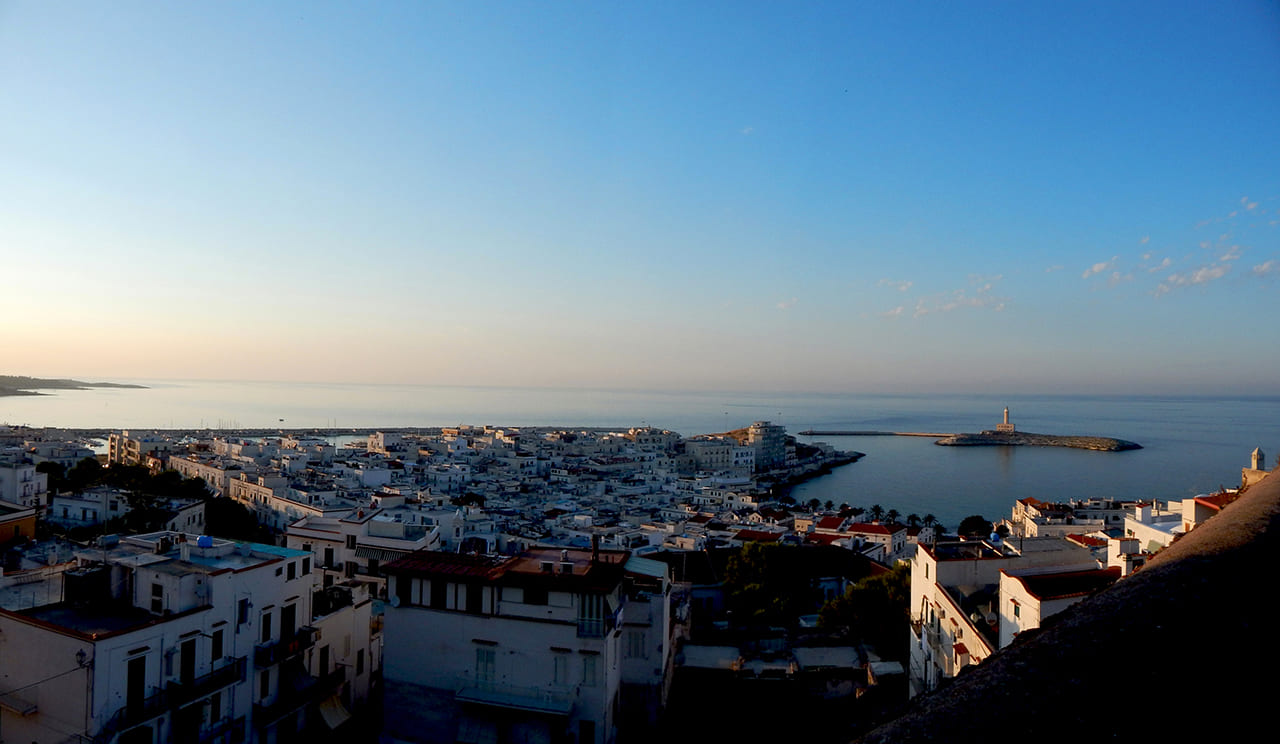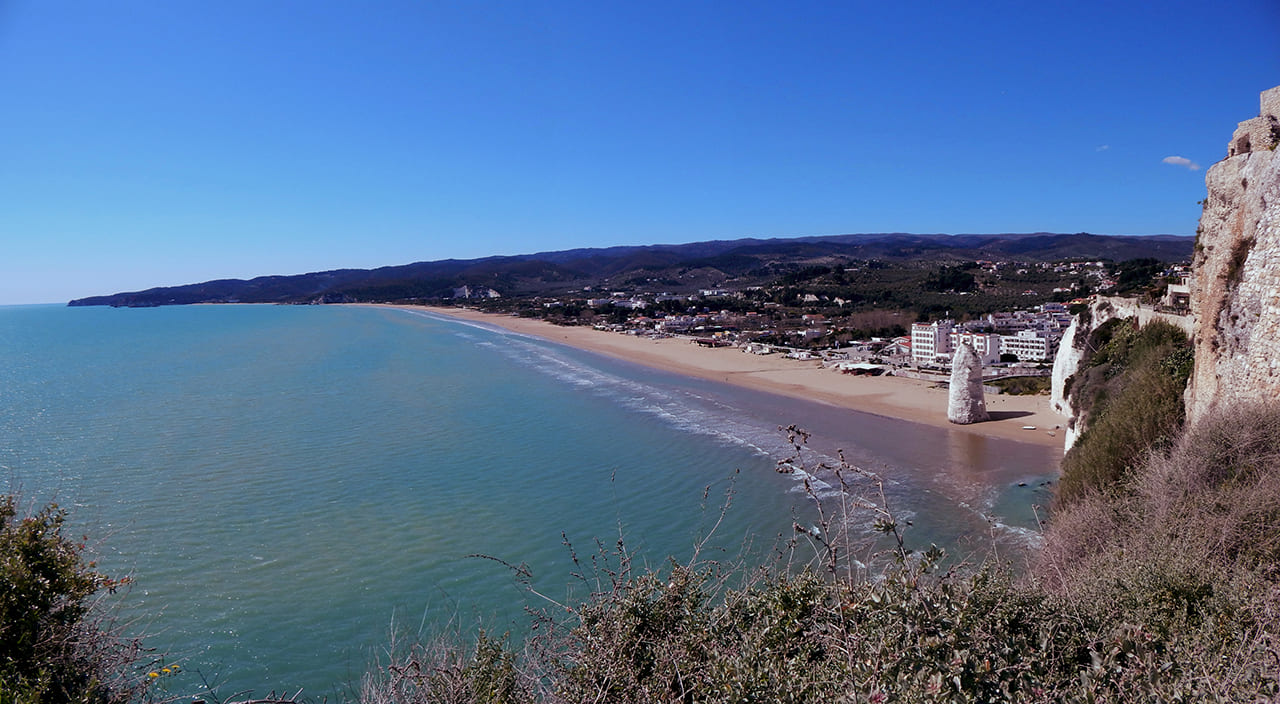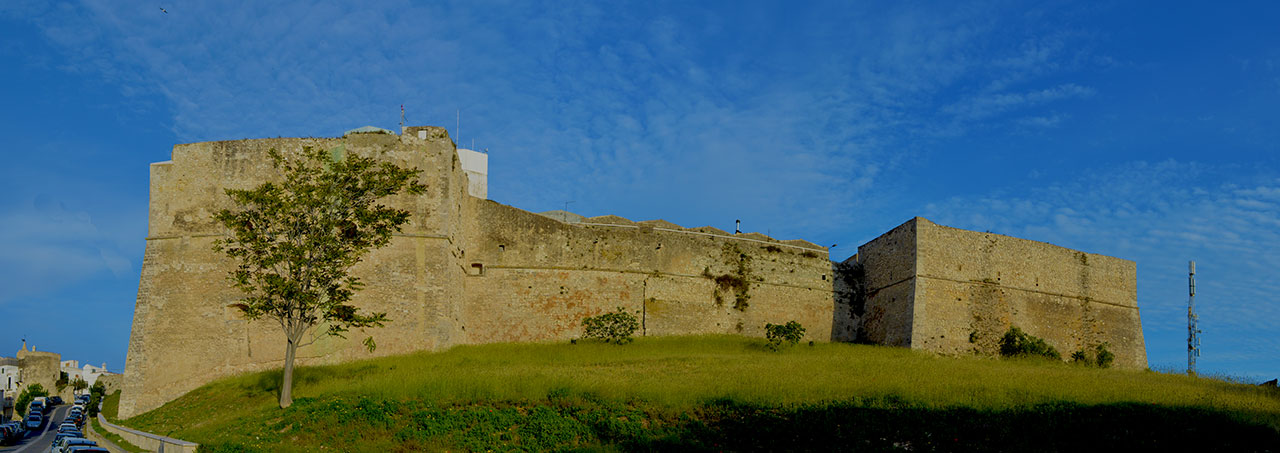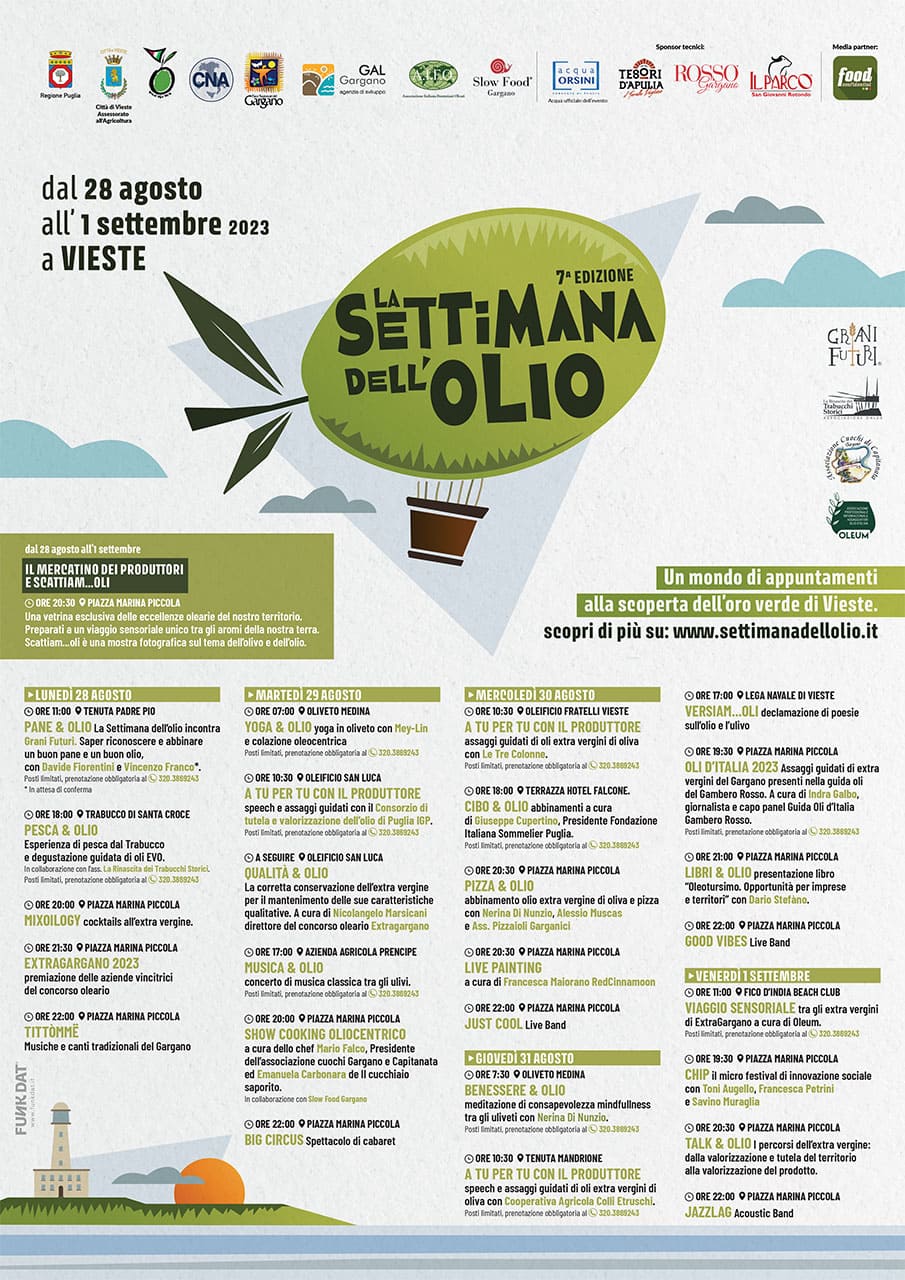Situato a Sud Ovest del centro storico, il castello fu edificato a strapiombo sul mare e domina il centro abitato. Non si hanno notizie relative alla sua origine, una pergamena redatta in occasione del Concilio di Melfi del 1059 è citato un “castellum quod dicitur Besti”. Ma è con i Normanni che accresce la sua importanza grazie allo sviluppo portuale della zona. Dai Regesta Federiciani si apprende che l’Imperatore Federico II di Svevia giunge a Vieste e vi dimora per circa un mese nel 1239 con lo scopo di garantire la sicurezza alla Capitanata con una serie di castelli, molti dei quali costruiti su preesistenti costruzioni militari realizzati da Longobardi, Bizantini e Normanni. Esso è anche documentato da una inchiesta angioina del 1285, all’epoca, Vieste era importante arsenale e sede di Protontino. Dieci anni più tardi, il 10 Maggio del 1295, il dimissionario Papa Celestino V, viene portato nel castello di Vieste per essere imprigionato in attesa di essere prelevato dai militari, mandati da Papa Bonifacio VIII, per condurlo a Fumone.Il castello fu riparato intorno al 1442 in occasione della venuta nella città del re Alfonso I di Aragona. L’introduzione delle armi da fuoco e l’evolversi della tecnica militare imposero l’uso di bastioni romboidali con mura scarpate, cannoniere e terrapieni, e quindi il castello subì delle trasformazioni, le parti più antiche furono incorporate e trasformate nei secoli successivi. In seguito alle incursioni della flotta ottomana il castello fu potenziato con la costruzione del baluardo ovest, che risale al 1559, durante il viceregno di don Perafan de Ribera. La fortezza fu gravemente danneggiata nel terremoto del 31 Maggio del 1646 che provocò, tra l’altro la caduta in mare di un intero bastione destinata a dormitorio per i soldati. Attualmente il castello di Vieste è sede di una stazione radar della Marina Militare.
Located to the south-west of the historic center, the castle was built overhanging the sea and dominates the town. There are no news of its origin, a parchment drawn up on the occasion of the Council of Melfi in 1059 is mentioned a “castellum quod dicitur Besti”. But it is with the Normans that it increases its importance thanks to the port development of the area. From the Regesta Federiciani we learn that emperor Frederick II of Swabia arrives in Vieste and resides there for about a month in 1239 with the aim of guaranteeing the safety of the Capitanata with a series of castles, many of which were built on pre-existing military buildings made by Longobards, Byzantines and Normans. It is also documented by an Angevin investigation of 1285, at the time, Vieste was an important arsenal and seat of Protontino. Ten years later, on May 10 1295, the resigning Pope Celestine V, was taken to the castle of Vieste to be imprisoned waiting to be picked up by the military, sent by Pope Boniface VIII, to lead him to Fumone. This castle was repaired around 1442 on the occasion of the coming to the city of King Alfonso I of Aragon. The introduction of firearms and the evolution of military technique imposed the use of rhomboidal bastions with escarpments and rampart, the oldest parts were incorporated and transformed in the following centuries. Following the incursions of the Ottoman fleet, the castle was upgraded with the construction of the west bulwark, which dates back to 1559, during the reign of Don Perafan de Ribera. The fortress was severely damaged in the earthquake of May 31 1646 that caused, among other things, the fall into the sea of an entire bastion used as a dormitory for soldiers. Nowadays the castle is currentl used to a Navy radar station.

MULTIMEDIALE
L’attuale pianta del castello di Vieste è triangolare e manca di un bastione distrutto nel 1646. L’interno si presenta abbastanza semplice e, per la sua posizione privilegiata, si possono ammirare panorami meravigliosi. L’accesso vero e proprio del castello è all’interno delle mura che si trovano in prossimità del torrione posto verso ovest ed avveniva tramite un ponte levatoio. Si accede così ad un piccolo atrio che porta ai vari ambienti più antichi del complesso. A sinistra vi sono degli ambienti che erano usati come prigione attigua al dormitorio dei soldati, affianco a questi vi è l’antica cappella, dedicata a Santa Barbara, a cui seguono altri piccoli locali e un belvedere. Uscendo sul belvedere si presenta un bellissimo panorama sulla costa meridionale di Vieste che inizia al monolite di Pizzomunno e termina fino alla Testa del Gargano, il punto più orientale di tutto il promontorio garganico. Sotto il belvedere si può osservare un’ accesso al castello a pochi metri di distanza dallo strapiombo che i viestani chiamano la Porta Falsa. Si tratta di uno stretto passaggio segreto usato dagli abitanti quando le porte della città erano chiuse. Per accedervi bisognava farsi riconoscere e lasciare tutto ciò che si portava con sé fuori per entrare nel castello. Il resto del complesso ha ospitato per molti anni la caserma, oggi in disuso, per alloggiare i militari della Marina Militare Italiana. Ritornando verso l’ingresso vi è un’antica scalinata che conduce sopra il bastione settentrionale, è uno dei rari esempi di antica pavimentazione in ciottoli che ancora esiste nell’area antica di Vieste. Subito dopo alcune costruzioni adibite ad alloggi infine si giunge all’ingresso della Sala Normanna, di forma circolare, in cui si possono ancora vedere le aperture usate per i cannoni al piano superiore mentre nell’area sottostante vi sono i resti di fondamenta risalenti all’epoca romana di una torre forse usata anche come faro. Uscendo dal ponte levatoio infine ci ritroviamo di fronte al bellissimo panorama costiero settentrionale che inizia con le bianche case del borgo ottocentesco e termina alla Torre di Sfinale che segna il confine tra Vieste e Peschici. Qui nelle giornate terse è possibile scrutare le sagome di alcune isole della Croazia.
The current plan of the castle is triangular and lacks a destroyed bastion in 1646. The interior is quite simple and, because of its privileged location, you can admire wonderful views. The actual access of the castle is inside the walls that are located near the west tower and took place through a drawbridge in the past. This leads to a small garden that leads to the various oldest environments of the complex. On the left there are rooms that were used as a prison near to the old dormitory of the soldiers, next to these we can see the ancient chapel, dedicated to Santa Barbara, followed by other small rooms and a viewpoint. Going out on the terrace there is a beautiful view of the southern coast of Vieste that begins at the Pizzomunno monolith and ends up at the Testa del Gargano, the easternmost point of the entire Gargano promontory. Under the viewpoint you can observe an access to the castle a few meters away from the overhang that the locals call Porta Falsa (False Door). It is a narrow secret passage used by the inhabitants when the city gates were closed. it was possible to use it if you had to be recognized and leave everything you took with you outside. The rest of the complex has used for many years as a military station, now in disuse, to house the italian navy military. Returning to the entrance there is an ancient staircase made in the 17th century that leads above the northern bastion, it is one of the rare examples of ancient cobblestone pavement present in Vieste. After some buildings used for housing finally you reach the entrance of the Norman Tower, circular in shape, in which you can still see the openings used for cannons on the upper floor while in the ground floor there are the remains of foundations dating back to roman times of a tower perhaps also used as a lighthouse. Leaving the drawbridge we finally admire the beautiful northern coastal panorama that begins with the white houses of the nineteenth-century district and ends at the Torre di Sfinale that marks the border between Vieste and Peschici. Here on clear days you can see the silhouettes of some of Croatia’s islands.
Der aktuelle Plan der Burg von Vieste ist dreieckig und es fehlt eine 1646 zerstörte Bastion. Der Innenraum ist ganz einfach und aufgrund seiner privilegierten Lage, können Sie eine herrliche Aussicht genießen. Das Innere ist wirklich einfach, und für seine besondere Position können Sie eine erstaunliche Aussicht bewundern. Der eigentliche Zugang zum Schloss erfolgt innerhalb der Mauern, die sich in der Nähe des Westturms über eine Zugbrücke befinden. Führt zu einem kleinen Atrium, das Zugang zu den anderen ältesten Räumen des Schlosses bietet. Links befindet sich das Gefängnis neben den Schlafsälen der Soldaten. Neben ihnen befindet sich eine alte Kapelle von Santa Barbara mit anderen kleinen Räumen und einem Aussichtspunkt. Neben ihnen befindet sich eine alte Kapelle von Santa Barbara mit anderen kleinen Räumen und einem Aussichtspunkt mit einem herrlichen Blick auf die Südküste von Vieste, angefangen vom Monolithen Pizzomunno bis zum Kopf von Gargano, dem östlichsten Punkt. Sie können einen Zugang unter dem Aussichtspunkt sehen, der als gefälschte Tür bezeichnet wird. Es wurde als schmaler Geheimgang benutzt, als die Türen der Stadt geschlossen wurden. Um hineinzukommen, mussten sie erkannt werden und all ihre Habseligkeiten draußen lassen. Zurück zum Eingang führt eine alte Treppe zur nördlichen Bastion, wo sich noch Reste des alten Steinpflasters in der Stadt befinden. Am Ende befindet sich der kreisförmige normannische Saal, mit oben einige Schlitze für die Kanonen und unten ein Rest eines römischen Turms. Der Rest des Schlosses wurde als Basis der Marines genutzt, aber jetzt nicht mehr. Außerhalb der Zugbrücke hat man einen herrlichen Blick auf die Nordküste von den weißen Häusern des 19. Jahrhunderts bis zum Sfinale-Turm, der Grenze zwischen Vieste und Peschici. Von hier aus können Sie die kroatischen Inseln sehen.
















